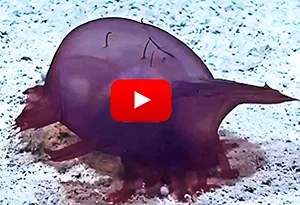Headless Chicken Monster Headless Chicken Fish
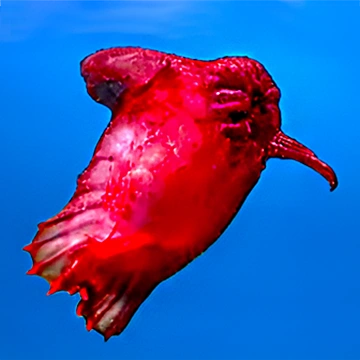
Photo: Headless chicken monster swimming
The headless chicken monster is a deep-sea swimming sea cucumber, that looks like a headless chicken. It has a reddish, jelly-like semi-transparent body, where you can see its internal organs. It is also bioluminescent and can glow in the dark. The headless chicken monster is also known as the Spanish dancer, headless chicken fish, and swimming sea cucumber. Its scientific name is Enypniastes eximia which means dreamer. It is the only animal in of its species.
Headless Chicken Monster - Description What Does a Headless Chicken Fish Look Like?
The headless chicken monster has a barrel-shaped body with a roundish mouth opening with tentacles at one end and an anus at the other. It grows to between 6-25 cm in length. Adult colours range from crimson, dark red and reddish-brown. Juveniles are usually pale pink.
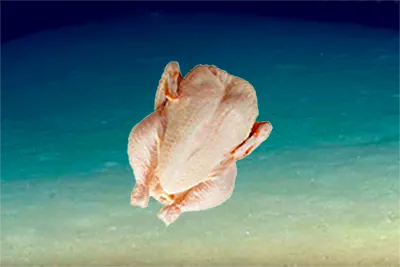
Photo: Why its called a Headless Chicken Monster
The most unique characteristic of the headless chicken monster is the composition of its body which is covered in a thin leathery skin and made up almost entirely of a gelatinous mass with a density slightly less than water. Because of this lighter density, there is natural buoyancy in the animal, permitting it to float just above the sea-floor. It can change the density of its gelatinous mass to vary the depth at which it floats. This lighter-than-water body allows the headless chicken monster to float effortlessly just above the sea-floor expending very little energy to move around. Other sea creatures that have a gelatinous body are the blobfish and jellyfish.
The headless chicken monster has no bones. But it does have an endoskeleton (i.e. skeleton inside the body), which lies just beneath its skin. This is made up of a very thin and simple calcium-based webbing which easily compresses to the extreme pressure of the deep sea without breaking.
The headless chicken monster has retained just enough muscle to perform the basic function of living. These include breathing which it does by pumping seawater in and out of an internal organ called a respiratory tree, opening its mouth and moving its tentacles for feeding just above the ocean floor, and moving its fins to navigate. Its low muscle mass and the limited usage of its muscles has an added benefit that it uses very little energy in movement.
The lifespan of the headless chicken monster is not know. However, given that it is a deep-sea creature, that usually have low metabolic rates, it is probably a long-living animal.
The Headless Chicken Monster is Bioluminescent The Headless Chicken Fish Glows in the Dark
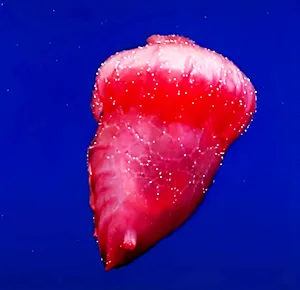
Photo: Headless Chicken Monster bioluminescent
The headless chicken monster is bioluminescent. That is, it can create and emit light. It does so with hundreds of specialised light-producing cells called granular cells. These cells lie just beneath its skin and are scattered throughout its body surface, feet and tentacle tips. The headless chicken monster’s luminosity is generated mechanically as a response to a stressful situation—typically an attack by a predator. A local stimulation results in a localized reaction that gradually spreads over the entire body of the animal. A broad impact results in its whole body becoming instantly luminescent and the animal shedding parts of its skin to generate a glowing cloud around it. This anti-predator behaviour may be designed to scare off a predator or to light up its surroundings to attract other visually-cued predators lurking nearby the attack its attacker, allowing the headless chicken monster to escape. The shed skin regenerates rapidly.
Headless Chicken Monster - Swimming & Walking How Does A Headless Chicken Fish Move About?
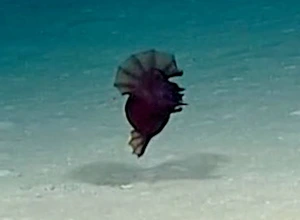
Photo: Headless Chicken Monster swimming
The headless chicken monster differs from other sea cucumbers in that it has fins. It has a Batman-like cape made up of a membrane stretched over twelve conically shaped feet (podia) on the front of its body and extending to the back where it has two paddle-like fins made up by stretching this bat-like membrane over ten more podia at the rear of its body. To swim, it unveils this cape, and rhythmical pulsates of this membrane to provide movement. This cape also acts as a sail to push it from point to point. In a panic, the headless chicken monster defecates (that is, it does an extreme poop) to lighten is bodyweight to make it more buoyant for escape. The two rear fins provide steering and stability. It can also use this Bat-cape like a parachute to slow its descent to the sea-floor.
The headless chicken monster does not walk as such. Its tube-feet are actually tentacles for feeding. To move on the sea-floor., it points itself downstream of a water current and using its cape on top of its head to push it along. The movement of tube-like feeders may also provide some assistance in movement.
Can You Eat a Headless Chicken Monster?
The headless chicken monster's body is gelatinous (like a jellyfish). Because it has very little muscle and is mostly made up of water, It also almost tasteless. As other sea cucumbers are eaten by people, it is conceivable that if it could be easily harvested it too could be eaten by some.
Headless Chicken Monster Diet What Do Headless Chicken Fish Eat?
The headless chicken monster eats micro-organisms such as bacteria and fungi and larger invertebrates, such as crustaceans and polychaetes. It moves along the seabed using a pushing motion of its tentacles. It feeds quickly, moving food into its mouth with its tentacles before moving away from the seafloor.
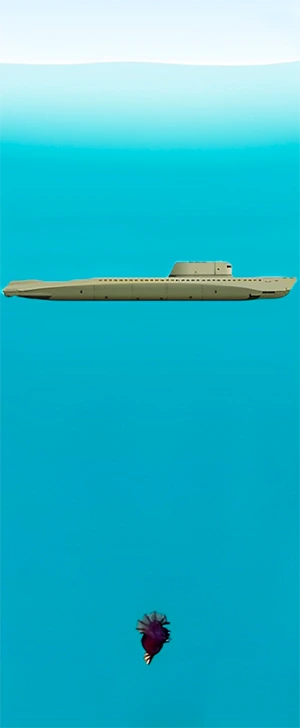
Photo: Depth at which chicken monster lives
Headless Chicken Monster Habitat Where do Headless Chicken Fish Live?
The headless chicken monster was found at a depths in excess of 3,000 meter below the surface, off the coast of Antarctica, about 4,000 kilometres southwest of Australia. It has also been seen in the Gulf of Mexico. Given the two widely dispersed locations where the chicken monster has been sighted so far, it is likely that it may be found worldwide. The true extent of this animal’s habitat and distribution is not known.
Headless chicken monsters are bottom dwellers, living close to the ocean floor at depths of more than 1,600 meters. This is more than 2.5 times deeper than even the most powerful submarine can go. At this depth, the water pressure is over 100 times greater than on land at sea level. Only specially designed undersea rovers can penetrate down to these depths.
No sunlight reaches these depths, and as a result, there is no vegetation of any sort. The water temperature is just above freezing (2.5 - 4 degrees Celsius).
Headless Chicken Monster Reproduction Baby Headless Chicken Fish
Like so much else about the headless chicken monster, very little is known about its reproductive habits.
Headless Chicken Monster - Predators & Threats What Kills Headless Chicken Fish?
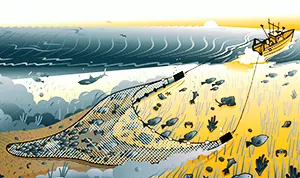
Photo: deep-sea trawling headless chicken fish
The main predator that may be endangering the headless chicken monster is humans. Deep-sea trawlers run nets down to the depths at which the headless chicken monster lives. Unfortunately, these animals can get caught in these fishing nets. Since it is commercially worthless, it is tossed back into the sea. But by then, it is too late for the headless chicken monster. It cannot survive out of its depth and is already dead.
Because so little is known about the headless chicken monster, we do not know if it has any natural predators or threats.
Headless Chicken Monster - Conservation Status Are Headless Chicken Fish Endangered?
We do not know if the headless chicken monster is endangered as no one knows what its population numbers are.
25 Headless Chicken Monster Facts
- The headless chicken monster is a swimming sea cucumber.
- It gets its name because its body looks like a decapitated chicken.
- It is also called the Spanish dancer because it looks like a flamingo dancer when it is swimming.
- It has a Batman-like cape which it opens out to sail through with the currents.
- Its two rear fins provide steering and stability.
- It lives 4,000km southwest of Australia.
- Its worldwide distribution is uncertain.
- Its body is made of a gelatinous substance covered in a thin leathery skin.
- The headless chicken monster is bioluminescent.
- It emits light to create its own light show.
- It lights up to scare off predators.
- When stressed, it sheds parts of its skin to generate a glowing cloud around it.
- With a body density less than water, it floats effortlessly above the sea floor.
- It can adjust its buoyancy to raise or lower itself in the water.
- You can see its internal organs through its reddish semi-transparent body.
- It grows to between 6-25 cm in length.
- The headless chicken monster has no bones.
- The headless chicken monster has just enough muscle to perform the basic function of living.
- This helps it save energy in movement.
- The headless chicken monster is a bottom dweller.
- It lives close to the ocean floor, at depths in excess of 1,600 meters.
- Here, the water temperature is just above freezing.
- The headless chicken monster moves along the seabed to feed.
- It uses its tentacles to pick up food off the ocean floor.
- It eats micro-organisms, crustaceans and polychaetes.
